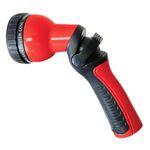Today’s photos are from Virginia Sherry, who is the founder of the Native Plant Society of Staten Island.
I am writing from Staten Island, New York, to share photos of my summer garden, which I have developed over the past 10 years to support pollinators. Many of the species are blooming; others will flower soon.
 Anise hyssop (Agastache foeniculum, Zones 4–8). This perennial is native to the Upper Midwest and Great Plains. The spikes of many small flowers are very attractive to pollinators and bloom over a very long season, particularly if kept deadheaded.
Anise hyssop (Agastache foeniculum, Zones 4–8). This perennial is native to the Upper Midwest and Great Plains. The spikes of many small flowers are very attractive to pollinators and bloom over a very long season, particularly if kept deadheaded.
 Sundrops (Oenothera fruticosa, Zones 3–9) are native to much of eastern North America. Durable and easy to grow, they bloom over a long period in early summer.
Sundrops (Oenothera fruticosa, Zones 3–9) are native to much of eastern North America. Durable and easy to grow, they bloom over a long period in early summer.
Common milkweed (Asclepias syriaca, Zones 3–9) is native to much of eastern North America and is famous as a main host for monarch butterfly caterpillars, but the showy, fragrant clusters of flowers attract a wide range of pollinators, including this little honeybee.
Despite being native to mostly wetlands in its native range over much of North America, swamp milkweed (Asclepias incarnata, Zones 3–6) thrives in regular garden soil. Unlike common milkweed, which spreads rapidly and can take over huge areas of a garden, this species stays more compact and may be a better choice for small gardens.
Native to Eastern Europe and Asia, stonecrop (here, Hylotelephium ‘Autumn Joy’, Zones 3–9) is much loved by pollinators when grown in North American gardens too.
Blanket flower (Gaillardia, Zones 5–9) is a short-lived perennial that blooms its heart out. Native mostly to the western and northern parts of North America, is thrives in dry, well-drained sites.
Soapwort (Saponaria officinalis, Zones 3–8) is a European species that was introduced to North America in colonial times and is common now along roadsides and other disturbed areas. The name “soapwort” comes from the traditional use of the sap from stems and roots to make soap.
Have a garden you’d like to share?
Have photos to share? We’d love to see your garden, a particular collection of plants you love, or a wonderful garden you had the chance to visit!
To submit, send 5-10 photos to [email protected] along with some information about the plants in the pictures and where you took the photos. We’d love to hear where you are located, how long you’ve been gardening, successes you are proud of, failures you learned from, hopes for the future, favorite plants, or funny stories from your garden.
Have a mobile phone? Tag your photos on Facebook, Instagram or Twitter with #FineGardening!
Do you receive the GPOD by email yet? Sign up here.
Fine Gardening Recommended Products
isYoung Birdlook® Smart Bird Feeder with Camera
Fine Gardening receives a commission for items purchased through links on this site, including Amazon Associates and other affiliate advertising programs.
Upgraded Dual Granary Bird Feeder. G11 Smart Bird Feeder with Camera – The upgraded dual granary design allows for separate food dispensing, giving birds the freedom to choose while preserving the food’s original taste. With a 2L extra-large capacity, it reduces the need for frequent refills. The drainage design ensures the food stays dry and prevents spoilage from rain. Ideal as a camera bird feeder for birdwatching enthusiasts. 2K HD Camera & Close-Up Bird Watching. Experience clear bird watching with the G11 smart bird feeder. This bird feeder with camera features a 170-degree wide-angle lens and a 1296P HD camera, ensuring vibrant images and videos. With AI-powered recognition, it can identify over 16,000 bird species (subscription required, first month free) and provides extensive birding knowledge. Its unique design helps attract more birds to your backyard. App Alerts & Super Night Vision. The smart bird feeder camera detects motion within 0.5 seconds and sends instant notifications through the "VicoHome" app. With a 2.4G Wi-Fi connection, you can view real-time updates on bird activity right from your app. The video bird feeder also features night vision, ensuring vibrant images and videos even in low light conditions. Ideal for wild bird feeders, this advanced functionality enhances your bird-watching experience day and night.
Fine Gardening receives a commission for items purchased through links on this site, including Amazon Associates and other affiliate advertising programs.
- Slim, lightweight design, is made with toxin-free polyurethane and utilizes industrial grade, lead-free fittings
- 3 Pounds
- 1200"L x 0.43"W
- Manufactured in the USA
Dramm Revolution Adjustable 9-Pattern Metal Hose Nozzle
Fine Gardening receives a commission for items purchased through links on this site, including Amazon Associates and other affiliate advertising programs.
- 15 x 10 x 7 inches
- Ergonomic insulated grip
- Maximum pressure of 90 PSI
- Fully adjustable spray pattern
- No trigger lock

 Anise hyssop (Agastache foeniculum, Zones 4–8). This perennial is native to the Upper Midwest and Great Plains. The spikes of many small flowers are very attractive to pollinators and bloom over a very long season, particularly if kept deadheaded.
Anise hyssop (Agastache foeniculum, Zones 4–8). This perennial is native to the Upper Midwest and Great Plains. The spikes of many small flowers are very attractive to pollinators and bloom over a very long season, particularly if kept deadheaded. Sundrops (Oenothera fruticosa, Zones 3–9) are native to much of eastern North America. Durable and easy to grow, they bloom over a long period in early summer.
Sundrops (Oenothera fruticosa, Zones 3–9) are native to much of eastern North America. Durable and easy to grow, they bloom over a long period in early summer.

























Comments
Love native plants.
After seeing your post here-I'm on a mission to find some Purple milkweed, A. purpurascens! My next mission will be trying to find more room in my garden for one more plant!
Loved seeing the pollinator plants in your garden- very inspiring and I learned something new!
I have several of these, but am going to look for a few I don't have. Lovely post!
Log in or create an account to post a comment.
Sign up Log in